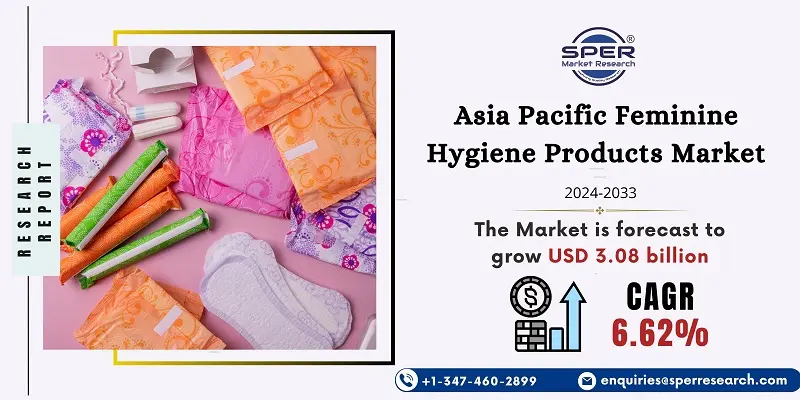
Asia Pacific Feminine Hygiene Products Market Trends, Share, Demand, Size and Future Outlook
Asia Pacific Feminine Hygiene Products Market Growth, Size, Trend Analysis- By Product Type, By Distribution Channel- Regional Outlook, Competitive Strategies and Segment Forecast to 2033
| Published: Nov-2024 | Report ID: FMCG24201 | Pages: 1 - 161 | Formats*: |
| Category : Consumer & Retail | |||
- June 2024: Kimberly-Clark released their annual sustainability report, which includes a new goal to have 100% Natural Forest Free goods by 2030, along with an update on the company's progress towards its 2030 sustainability targets.
- November 2022: By purchasing Billie Inc., a US-based consumer brand firm, Edgewell Personal Care firm increased the range of products it offered for women's personal care.


| Report Metric | Details |
| Market size available for years | 2020-2033 |
| Base year considered | 2023 |
| Forecast period | 2024-2033 |
| Segments covered | By Product Type, By Distribution Channel |
| Regions covered | Australia, China, India, Japan, South Korea, Rest of Asia-Pacific. |
| Companies Covered | Edgewell Personal Care Co., Kimberly-Clark Corp, Lune Group Oy Ltd, Mooncup Ltd, Ontex BV, Essity AB, The Procter & Gamble Co, Unicharm Corporation, Kao Corporation, Others. |
- Teenage girls
- Working women
- College and university students
- Urban women
- Rural women
- Environmentally-conscious consumers
- Low-income households
- Health-conscious individuals
- Pregnant and postpartum women
- Elderly women
| By Product Type: | |
| By Distribution Channel: |
- Asia Pacific Feminine Hygiene Products Market Size (FY’2024-FY’2033)
- Overview of Asia Pacific Feminine Hygiene Products Market
- Segmentation of Asia Pacific Feminine Hygiene Products Market by Product Type (Sanitary Napkins, Tampons, Menstrual Cup, Panty liners, Feminine Hygiene Wash)
- Segmentation of Asia Pacific Feminine Hygiene Products Market by Distribution Channel (Hypermarket, Supermarket, Convenience Stores, Department Stores, Retail Pharmacies, Online Purchase)
- Statistical Snap of Asia Pacific Feminine Hygiene Products Market
- Expansion Analysis of Asia Pacific Feminine Hygiene Products Market
- Problems and Obstacles in Asia Pacific Feminine Hygiene Products Market
- Competitive Landscape Asia Pacific Feminine Hygiene Products Market
- Impact of COVID-19 and Demonetization Asia Pacific Feminine Hygiene Products Market
- Details on Current Investment in Asia Pacific Feminine Hygiene Products Market
- Competitive Analysis of Asia Pacific Feminine Hygiene Products Market
- Prominent Players in the Asia Pacific Feminine Hygiene Products Market
- SWOT Analysis of Asia Pacific Feminine Hygiene Products Market
- Asia Pacific Feminine Hygiene Products Market
- Future Outlook and Projections (FY’2024-FY’2033)
- Recommendations from Analyst
1.1. Scope of the report1.2. Market segment analysis
2.1. Research data source
2.1.1. Secondary Data2.1.2. Primary Data2.1.3. SPERs internal database2.1.4. Premium insight from KOLs
2.2. Market size estimation
2.2.1. Top-down and Bottom-up approach
2.3. Data triangulation
4.1. Driver, Restraint, Opportunity and Challenges analysis
4.1.1. Drivers4.1.2. Restraints4.1.3. Opportunities4.1.4. Challenges
4.2. COVID-19 Impacts of the Asia Pacific Feminine Hygiene Products Market.
5.1. SWOT Analysis
5.1.1. Strengths5.1.2. Weaknesses5.1.3. Opportunities5.1.4. Threats
5.2. PESTEL Analysis
5.2.1. Political Landscape5.2.2. Economic Landscape5.2.3. Social Landscape5.2.4. Technological Landscape5.2.5. Environmental Landscape5.2.6. Legal Landscape
5.3. PORTERs Five Forces
5.3.1. Bargaining power of suppliers5.3.2. Bargaining power of buyers5.3.3. Threat of Substitute5.3.4. Threat of new entrant5.3.5. Competitive rivalry
5.4. Heat Map Analysis
6.1. Asia Pacific Feminine Hygiene Products Market Manufacturing Base Distribution, Sales Area, Product Type6.2. Mergers & Acquisitions, Partnerships, Product Launch, and Collaboration in Asia Pacific Feminine Hygiene Products Market
7.1. Asia Pacific Feminine Hygiene Products Market Size, Share and Forecast, By Product Type, 2020-20267.2. Asia Pacific Feminine Hygiene Products Market Size, Share and Forecast, By Product Type, 2027-20337.3. Sanitary Napkins7.4. Tampons7.5. Menstrual Cup7.6. Panty liners7.7. Feminine Hygiene Wash
8.1. Asia Pacific Feminine Hygiene Products Market Size, Share and Forecast, By Distribution Channel, 2020-20268.2. Asia Pacific Feminine Hygiene Products Market Size, Share and Forecast, By Distribution Channel, 2027-20338.3. Hypermarket8.4. Supermarket8.5. Convenience Stores8.6. Department Stores8.7. Retail Pharmacies8.8. Online Purchase
9.1. Asia Pacific Feminine Hygiene Products Market Size and Market Share
10.1. Asia Pacific Feminine Hygiene Products Market Size and Market Share By Region (2020-2026)10.2. Asia Pacific Feminine Hygiene Products Market Size and Market Share By Region (2027-2033)10.3. Asia-Pacific
10.3.1. Australia10.3.2. China10.3.3. India10.3.4. Japan10.3.5. South Korea10.3.6. Rest of Asia-Pacific
11.1. Edgewell Personal Care Co
11.1.1. Company details11.1.2. Financial outlook11.1.3. Product summary11.1.4. Recent developments
11.2. Kimberly-Clark Corp
11.2.1. Company details11.2.2. Financial outlook11.2.3. Product summary11.2.4. Recent developments
11.3. Lune Group Oy Ltd
11.3.1. Company details11.3.2. Financial outlook11.3.3. Product summary11.3.4. Recent developments
11.4. Mooncup Ltd
11.4.1. Company details11.4.2. Financial outlook11.4.3. Product summary11.4.4. Recent developments
11.5. Ontex BV
11.5.1. Company details11.5.2. Financial outlook11.5.3. Product summary11.5.4. Recent developments
11.6. Essity AB
11.6.1. Company details11.6.2. Financial outlook11.6.3. Product summary11.6.4. Recent developments
11.7. The Procter & Gamble Co
11.7.1. Company details11.7.2. Financial outlook11.7.3. Product summary11.7.4. Recent developments
11.8. Unicharm Corporation
11.8.1. Company details11.8.2. Financial outlook11.8.3. Product summary11.8.4. Recent developments
11.9. Kao Corporation
11.9.1. Company details11.9.2. Financial outlook11.9.3. Product summary11.9.4. Recent developments
11.10. Others
SPER Market Research’s methodology uses great emphasis on primary research to ensure that the market intelligence insights are up to date, reliable and accurate. Primary interviews are done with players involved in each phase of a supply chain to analyze the market forecasting. The secondary research method is used to help you fully understand how the future markets and the spending patterns look likes.
The report is based on in-depth qualitative and quantitative analysis of the Product Market. The quantitative analysis involves the application of various projection and sampling techniques. The qualitative analysis involves primary interviews, surveys, and vendor briefings. The data gathered as a result of these processes are validated through experts opinion. Our research methodology entails an ideal mixture of primary and secondary initiatives.



Frequently Asked Questions About This Report
PLACE AN ORDER
Year End Discount
Sample Report
Pre-Purchase Inquiry
NEED CUSTOMIZATION?
Request CustomizationCALL OR EMAIL US
100% Secure Payment






Related Reports
Our Global Clients
Our data-driven insights have influenced the strategy of 200+ reputed companies across the globe.




















